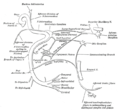Geniculate ganglion
| Geniculate ganglion | |
|---|---|
muscles of facial expression | |
| Identifiers | |
| Latin | ganglion geniculi nervi facialis |
| MeSH | D005830 |
| TA98 | A14.2.01.116 |
| TA2 | 6287 |
| FMA | 53414 |
| Anatomical terms of neuroanatomy] | |
The geniculate ganglion (from
The geniculate ganglion is one of several ganglia of the head and neck. Like the others, it is a bilaterally distributed structure, with each side of the face having a geniculate ganglion.
Structure
The geniculate ganglion is located close to the internal auditory meatus.[2] It is covered superiorly by the petrous part of the temporal bone (which is sometimes absent over the ganglion).[3]
The geniculate ganglion receives fibers from the motor, sensory, and
The motor fibers of the facial nerve proper and parasympathetic fibers to the submandibular and pterygopalatine ganglia do not synapse in the geniculate ganglion. The afferent fibers carrying pain, temperature, and touch from the posterior auricular nerve, as well as those carrying special sensory (taste) fibers from the tongue (via the chorda tympani), do not synapse in the geniculate ganglion. Instead, the cells of the geniculate ganglion relay the signal to the appropriate brainstem nucleus, much like the Dorsal root ganglion neurons relay signal to nuclei in the spinal cord.[5]
Function
Via the geniculate ganglion, the facial nerve (CN VII) gives[6]
- parasympathetic innervation to:
- the lacrimal glands.
- the submandibular glands.
- the sublingual glands.
- special sensory innervation to:
- general sensory innervation to:
- skin of the posterior ear
- somatic (branchial) motor innervation to:
- the palate
- the pharynx.
- the external auditory meatus
- the stapedius muscle.
- the posterior belly of the digastric muscle.
- the stylohyoid muscle.
- muscles of facial expression.
Clinical significance
The geniculate ganglion is an important surgical landmark near the internal auditory meatus.[2]
The geniculate ganglion may become
Additional images
-
Plan of the facial and intermediate nerves and their communication with other nerves.
See also
- Ramsay Hunt syndrome type II
References
- ^ "genu-, geni-, gen- + (Latin: knee)". WordInfo. Retrieved 2008-10-03.
- ^ ISSN 0003-9977.
- .
- ISBN 978-0-7020-3738-2.[page needed]
- ISBN 978-1-4511-1945-9.
- OCLC 1076750418.
- ISSN 0379-864X.
- ISSN 0022-3018.
External links
- cranialnerves at The Anatomy Lesson by Wesley Norman (Georgetown University) (VII)
- lesson3 at The Anatomy Lesson by Wesley Norman (Georgetown University) (midearcavity)

